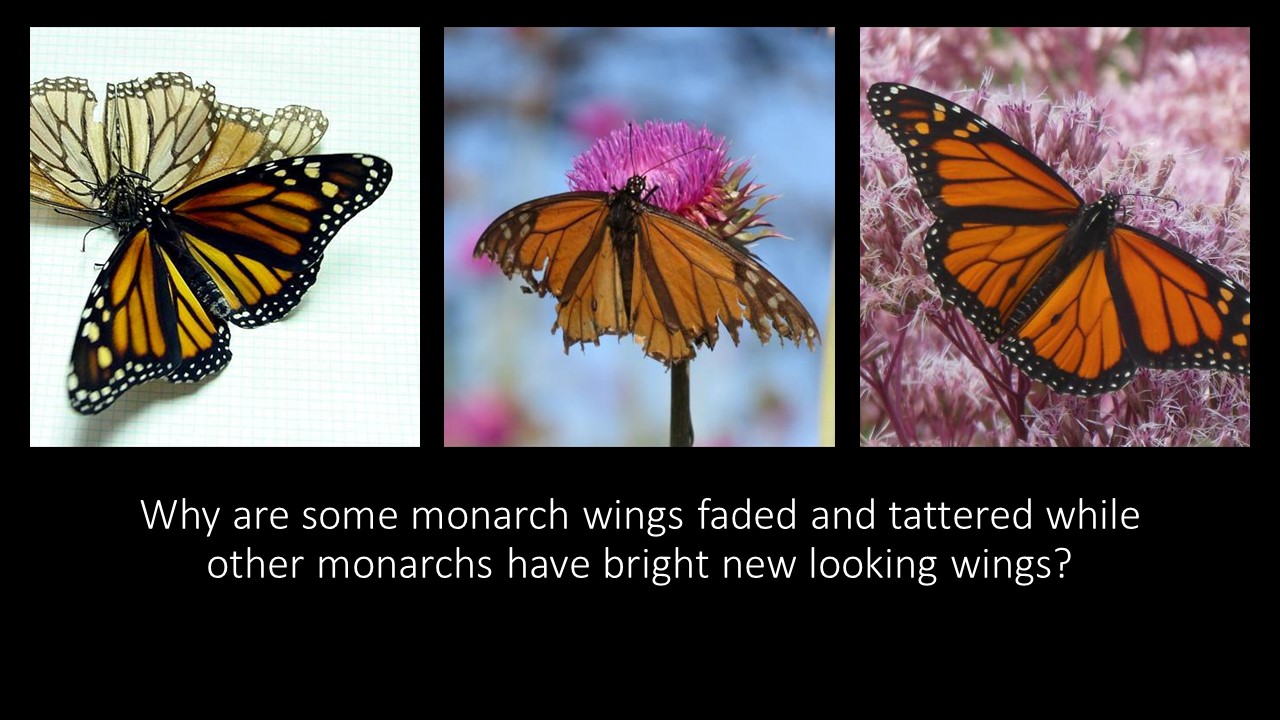New wings-When a monarch emerges from its chrysalis, it's born with vivid orange wings in pristine condition. Monarch with new looking wings
Old and Worn Wings -- Tattered wings that begin as fresh as a flower become dull, tattered, and torn over time. What happens? Old and Worn Wings
Rough Encounters -- Over the course of a butterfly's life, its wings can be scratched by thorns, bristles, branches, grasses or anything sharp it encounters. Rough encounters
Weather Worn Wings -- Wings can be damaged by wind, hail, snow, or rain. This female's forewings were tattered in a storm. The wind may have tossed her around or she may have been struck by flying debris. Weather and Wings
Tears and Scratches - Narrow escapes sometimes the tears or scratches on a wing show evidence of a predator. The V-shaped scratch on this female's hind wing was likely made by the beak of a bird. Tears and Scratches
Sticky Situations -- A butterfly may escape a spider's web but its wings may be damaged by the struggle. The sticky silk threads can remain clinging, too. caught in spider web
Losing Color -- After many scrapes, scratches, nicks, and tears, a monarch no longer appears bright orange. Losing Color
Magnified Wing -- The surface of a monarch's wing is covered with thousands of tiny, flat, colorful scales. As the monarch loses these scales, it loses its color. Magnified Wing
Losing Scales -- As the scales are scraped off, the clear, paper-thin wing underneath becomes visible. Losing Scales
Wings Show Age -- The color and condition of a monarch's wings reveal its age. The young butterfly is vividly colored. The light-colored monarch is 7 months old and has lost most of its scales. Wings Show Age
Final Flights -- By April, monarchs of the overwintering generation from Mexico have only a few weeks to live. The worn-winged butterflies are no longer their brilliant orange. Final Flight
A New Generation -- By May, a new generation of monarchs emerges. On fresh wings, these butterflies will complete the spring migration. A New Generation
Hidden Colors - How can monarchs hide their bright orange wings? This picture holds a clue. Hidden Colors
Camouflauge Helps - Monarch wings are brightly colored on the upper side only. The undersides are a pale orange. When monarchs close their wings they are harder to see or camouflaged. Camouflauge Helps
Wings Solar Collectors-- How are monarch wings like solar collectors? What clues can you find in this photo?These monarchs are using their wings to bask in the sun! Dark colors absorb solar energy well. Basking is a way butterflies can warm their flight muscles. Monarch butterflies can't fly until their muscles are at least 60°F. Wings Solar Collectors

